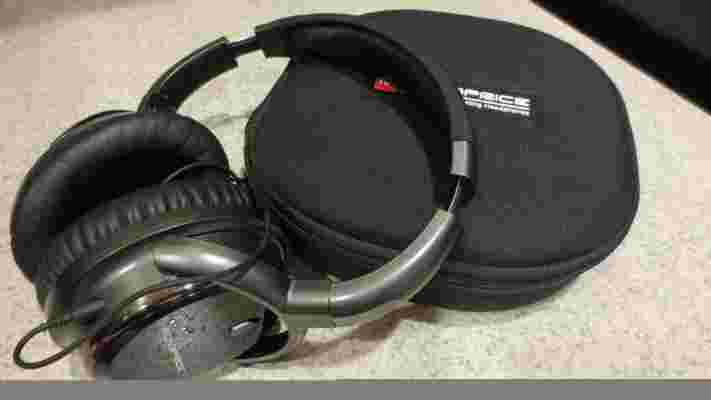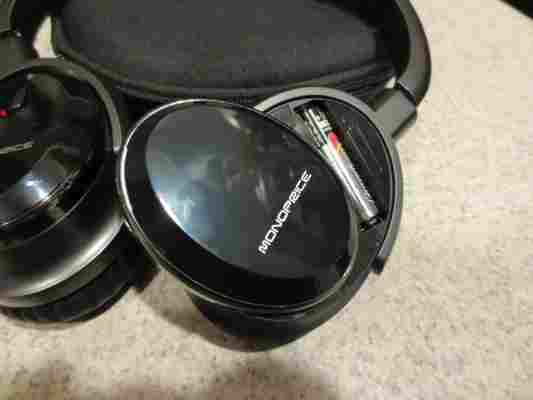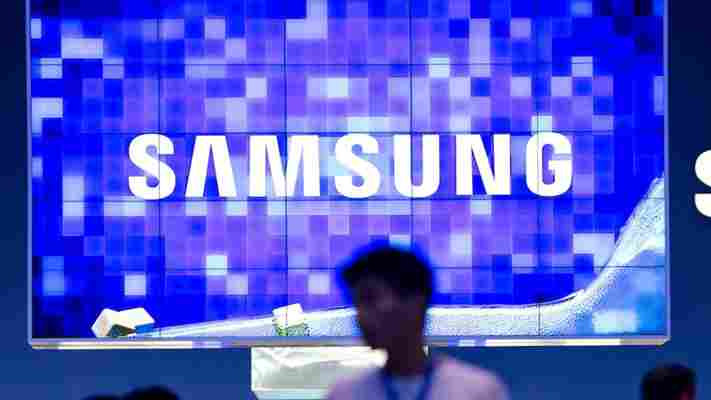In the world of active noise canceling (ANC) headphones, Bose tends to be the weapon of choice. The company has made quite a name for itself with the QuietComfort series , and for good reason — Most ANC headphones tend to be bulky, devoid of good sound and generally very expensive. Bose nipped two out of those three problems, leaving only the $300 price tag as a concern. But discount retailer Monoprice has entered the market with a set of ANC headphones for a mere $113. Can they compare? Read on.

The Monoprice headphones come in a fancy box. Inside this fancy box you’ll find a reinforced soft case (it will stand up to getting shoved in a backpack, but don’t sit on it) that contains the headphones, a straight and mobile cable, an airline adapter and a stereo-mini to quarter-inch adapter and a AAA-sized battery for power. No more, no less. Nothing about the product screams money, and that’s for good reason. Remember that you only paid $100 for these.
After picking the cable that suits your need and plugging it into the side you might be taken by surprise at the fact that these headphones will work without powering them on. It’s commonplace in the world of ANC to not have this feature, as the acoustics of a powered versus passive device are quite different. As such, if you run out of battery halfway across the Atlantic, you’re just out of luck. Monoprice has done an admirable job of keeping decent sound quality in the passive mode, but the volume is considerably lacking.
In short, the Monoprice headphones are the polar opposite of what we’ve seen from brands like Bose and Beats by Dre. The BBD Executive headphones that we reviewed a few months back also required two batteries, were heavier and overall less comfortable for longer listening.
Powering up the headphones, you’ll immediately notice a significant boost in volume, while the world around you suddenly becomes quite silent. As is common with ANC technology, it works better for droning sounds such as a train or an airplane engine. Office environments get blocked out quite well too, but you’ll still hear the occasional spike of sound from outside of your ear cups.
Long periods spent wearing the Monoprice headphones won’t leave you with sore ears or a numb head from the band. There is sufficient, soft padding and the leatherette (read: fake leather) covering does a good job of not getting uncomfortably hot. If I had to have a gripe about them, it would be that the wires which come with the headphones are thinner than I’d like to see. Fortunately, since they’re modular, you can replace them with something of better quality should the unexpected(?) happen.


Getting down to brass tacks, ANC headphones from any company aren’t going to win awards for sound quality. Though the technology has gotten impressive over the years, there’s still too much going on with the tech side of things to leave unfettered audio. Bearing that in mind, if you want to save some cash and go with the Monoprice offering, you’ll also need to be aware that they’re not going to be the best-sounding headphones you’ve owned.
Purely from an audio quality standpoint, the Monoprice ANCs sound much better when they’re used in passive mode. If I were a betting man, I’d say that the OEM for these headphones spent more time tuning them to the passive mode, and then added ANC as a feature, sound be damned. That’s not to say that they sound bad in active mode, but they’re not going to be stellar.
What you have, in the Monoprice offering, is a product that is less fancy, but there’s a price tag to match. In fact, if I were blind testing these, I’d say that they’d be in the $175-200 range, rather than the $100 point where they actually reside. Whether or not you go for ANC is still a personal decision, but if you’re in the market for a pretty great set of ANC headphones, these will keep you happy without even a moment of buyer’s remorse from the price.
➤ Monoprice Active Noise Canceling Headphones
Google updates Google TV to Android Jelly Bean and Chrome 26, announces faster update cycle
Today following its yearly I/O developer keynote , Google has announced that Google TV is moving to Android Jelly Bean (version 4.2.2) and the latest version of Chrome (26). Google says existing Google TVs will “start to receive updates in the coming months.”

For manufacturers, Google says it is “refactoring” it’s update cycle so “partners can update to future versions of Android in a matter of weeks rather than months.” This will clearly make the platform more attractive to developers — it needs all the help it can get. The same goes for Chrome, which will now be updated every six weeks on Google TV, just like it is on other platforms.
Google was quick to point out that developers will now be able to “build TV experiences using the latest Android APIs, including the NDK.” Additionally, Chrome for Google TV is receiving “support for hardware-based content protection, enabling developers to provide premium TV content in HD within their web apps. ”
As for upcoming hardware, Google remained rather vague, and simply said “we expect to see new [Google TV] devices launched later this year.”
Google TV has gone through a curious evolution since launching back in October 2010 , but throughout this time, the general mission of bringing Web-based entertainment (like Netflix, YouTube) and Google search technology to your television has remained unchanged.
Logitech’s Revue was the first Google TV device announced , but the launch ended up being a complete and utter flop . In fact, Logitech even went as far as admitting that the Revue “ was a big mistake .” Nevertheless, new iterations of Google TV have since been released, the latest being the Asus Qube and Netgear’s NeoTV Prime — both announced earlier this year.
Google arrived early to the connected TV game, along with companies like Boxee and Roku, but the space is now more competitive than ever: the Apple TV continues to sell extremely well , Microsoft’s next Xbox is said to offer more general entertainment features, Amazon is reportedly planing to release a set-top box for video streaming , and then there’s the Samsung Smart TV and the Smart TV Alliance , which includes LG, Toshiba and Panasonic.
Right now, Google is surely hoping its third generation of devices fares better than its first, but this space is clearly only getting more crowded. What’s worse is that Google appears to be moving Google TV to hobby status, which won’t be very encouraging for curious developers or consumers.
Image credit: Adam Berry/Stringer/Getty Images
Samsung’s Galaxy Gear smartwatch leak shows a fitness device with Android apps and a camera
Samsung is set to unveil its smartwatch, the Galaxy Gear, in a couple of days on September 4. For those who can’t wait to see it, Venture Beat revealed a leaked prototype of the watch over the weekend, showcasing a smartwatch that is more of a wearable fitness device than anything else.

The leaked prototype shows a Galaxy Gear smartwatch that measures three inches diagonally across a square screen, and comes with a four-megapixel camera as well as preloaded Android apps. It reportedly has Bluetooth capabilities to connect with the Galaxy S series, and can also connect to all Android devices. It is also said to have Wi-Fi capabilities.
Venture Beat says the smartwatch has a focus on health and fitness — a few features include letting you track your health data, measure your heart rate, set up a workout targeted at different goals, and track your food intake.
➤ This is Samsung’s Galaxy Gear smartwatch: A blocky health tracker with a camera [Venture Beat]
Headline Image Credit: Odd Andersen via AFP/Getty Images , screenshots via Venture Beat
